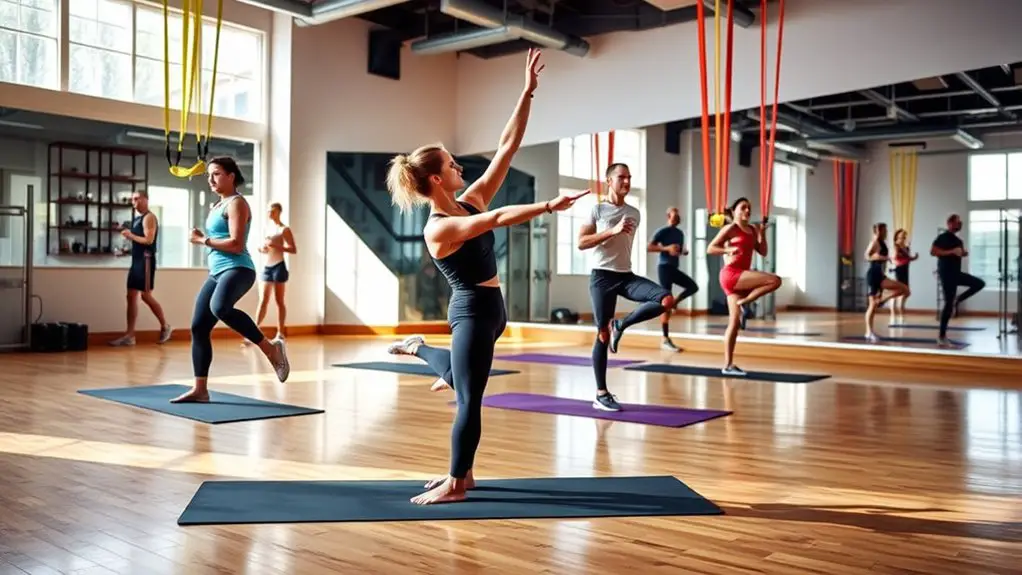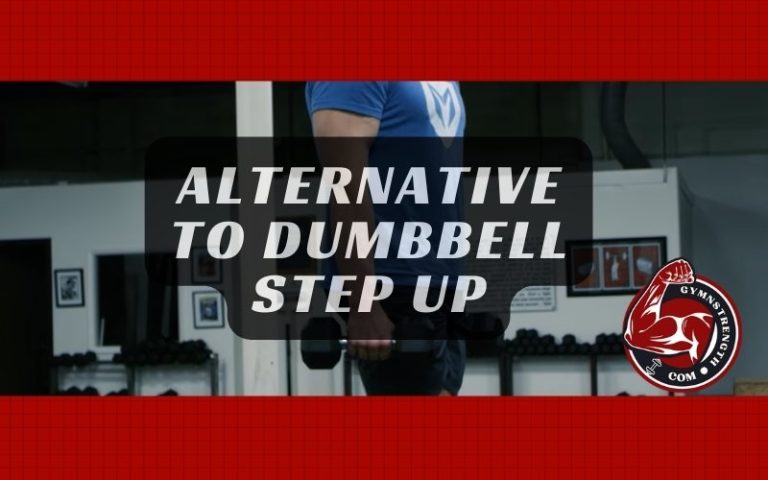Best Gym Workouts for Runners

To enhance your running performance, focus on strength training, plyometrics, and core workouts. Incorporate banded squats and box jumps to build strength and speed. Core exercises like planks will improve stability and posture. Don’t forget flexibility and mobility routines to prevent injuries. Cross-training with swimming or cycling offers low-impact benefits. Finally, prioritize recovery with foam rolling and hydration. Keep going, and you’ll discover even more strategies to boost your running game.
Strength Training for Runners

While running builds endurance, incorporating strength training into your routine can enhance your performance and reduce the risk of injury. To get started safely, make sure you include dynamic warm-ups before every session. These can help prepare your muscles and joints, making them more resilient during your workout.
Using resistance bands is a fantastic way to strengthen key muscle groups without straining yourself. Focus on exercises that target your core, hips, and glutes, as these areas are essential for maintaining good running form. Simple movements like banded squats and lateral walks can improve your stability and power. Additionally, incorporating goblet squats into your routine can help improve balance and engagement while building strength.
Remember to listen to your body and avoid pushing too hard too soon. Gradually increase the intensity and frequency of your strength sessions, ensuring you’re complementing your running, not hindering it. With a balanced approach, you’ll be on your way to a stronger, injury-free running experience.
Plyometric Exercises to Boost Speed
Plyometric exercises can really enhance your speed and explosiveness as a runner. By incorporating key movements into your routine, you’ll not only boost your performance but also reduce the risk of injuries. Let’s explore the benefits of plyometric training and some effective exercises to get you started.
Benefits of Plyometric Training
If you want to enhance your running speed and overall performance, incorporating plyometric training into your routine can be incredibly beneficial. Plyometric exercises focus on explosive movements that improve your strength and agility, leading to significant plyometric benefits. By developing explosive power, you’ll find yourself faster on the track and more efficient in your stride. These exercises also help improve your coordination and balance, reducing the risk of injury while running. Just remember to start slowly and pay attention to your form to guarantee safety. Gradually increase intensity and volume as your body adapts. With consistent plyometric training, you’ll not only boost your speed but also elevate your overall athletic performance.
Key Plyometric Exercises
Incorporating key plyometric exercises into your training can greatly enhance your speed and overall performance as a runner. Two excellent exercises to evaluate are box jumps and depth jumps. Both focus on explosive strength, helping you to improve your power and speed on the track.
| Exercise | Description | Safety Tips |
|---|---|---|
| Box Jumps | Jump onto a sturdy box or platform. | Use a height you’re comfortable with. Land softly. |
| Depth Jumps | Step off a box, then jump upon landing. | Avoid excessive height. Focus on cushioning your landing. |
| Broad Jumps | Jump forward as far as possible. | Verify a clear landing area. Keep knees aligned. |
Start with lower heights and gradually increase as you gain confidence and strength. Always prioritize proper form to prevent injury.
Incorporating Plyometrics Into Routine
To boost your speed as a runner, adding plyometric exercises to your routine can be a game-changer. These explosive movements, like box jumps and jump squats, enhance your power and agility, translating to faster race times. Start slowly to avoid injury; proper form is essential. Incorporate two to three plyometric sessions each week, focusing on quality over quantity. Aim for about 10-15 reps per set with adequate rest in between. The plyometric benefits also extend to improved coordination and balance, making you a more efficient runner. Listen to your body, and if you feel any discomfort, adjust your intensity. With consistent practice, you’ll notice significant speed improvements, helping you reach your running goals safely.
Core Workouts for Stability and Endurance
Your core is essential for maintaining stability and endurance while running, and strengthening it can enhance your overall performance. Effective core exercises not only improve your posture but also help prevent injuries. Let’s explore some key workouts that will build your core strength and support your running goals. Incorporating exercises like AB Wheel Rollout alternatives can provide variety and challenge to your core training.
Importance of Core Strength
While many runners focus primarily on their legs, neglecting core strength can lead to imbalances and injuries. A strong core is crucial for maintaining proper form and stability during your runs. When you engage in dynamic stretching, it not only warms up your muscles but also activates your core, enhancing your overall performance. Core stability helps you maintain balance, especially when traversing uneven terrain or during long distances. Plus, a solid core supports your lower back, reducing the risk of strain. By prioritizing core workouts, you’re investing in your endurance and injury prevention, allowing you to run longer and more efficiently. Remember, a well-rounded training regimen includes strengthening those important core muscles for peak safety and performance.
Effective Core Exercises
Many athletes underestimate the power of a strong core in enhancing running performance. A well-developed core provides stability and endurance, making your runs more efficient and reducing injury risk. Here are some effective exercises you can incorporate into your routine:
- Plank variations: Try side planks or plank jacks to challenge your core in different ways.
- Stability ball: Use it for exercises like roll-outs or wall squats to engage multiple muscle groups.
- Russian twists: This classic move works your obliques and can be done with or without weights.
Always focus on maintaining proper form to prevent injuries. By prioritizing these core workouts, you’ll find yourself running stronger and longer with greater confidence.
Flexibility and Mobility Routines

Incorporating flexibility and mobility routines into your training can enhance your performance as a runner and reduce the risk of injury. Start with dynamic stretching before your workouts to warm up your muscles and increase your range of motion. Focus on movements like leg swings and walking lunges to prepare your body for running. After your sessions, foam rolling can help alleviate tightness and improve muscle recovery. Spend a few minutes rolling out your quads, hamstrings, and calves to keep your muscles pliable and reduce soreness.
Additionally, consider incorporating yoga or dedicated stretching routines into your weekly schedule. These practices can improve flexibility, posture, and balance, making you a more efficient runner. Remember, the goal is to maintain your body’s mobility, so listen to your body and avoid pushing through pain. Prioritizing these routines can lead to safer and more effective training sessions.
Cross-Training Options for Improved Performance
Maintaining flexibility and mobility is just one piece of the puzzle for runners looking to enhance their performance. Cross-training is a fantastic way to build endurance and strength while reducing the risk of injury. It offers unique benefits that can greatly improve your running game.
Cross-training enhances endurance and strength while minimizing injury risk, making it essential for runners aiming to improve their performance.
Consider incorporating these cross-training options into your routine:
- Swimming: A low-impact way to boost cardiovascular endurance while protecting your joints.
- Cycling: Great for building leg strength and stamina without the harsh impact of running.
- Strength Training: Focuses on core stability and muscle balance, essential for maintaining proper running form.
Recovery Strategies to Prevent Injuries

While pushing your limits is vital for improvement, ignoring recovery can lead to injuries that sideline your progress. Implementing effective recovery strategies is fundamental for injury prevention and overall performance enhancement. Active recovery, such as light jogging, swimming, or cycling, allows your muscles to repair while keeping blood flowing, promoting healing without undue strain.
Incorporate rest days into your routine to give your body the time it needs to recover fully. Stretching and foam rolling can also alleviate tightness and improve flexibility, reducing the risk of injuries. Don’t underestimate the power of hydration and proper nutrition; fueling your body with the right nutrients supports recovery and prepares you for your next workout. Additionally, proper form and technique during workouts like jumping rope can significantly minimize the risk of knee injuries.
Lastly, listen to your body. If you feel pain or excessive fatigue, it’s important to adjust your training accordingly. Remember, a well-rounded approach to recovery is key to staying injury-free and achieving your running goals.
Frequently Asked Questions
How Many Days a Week Should Runners Strength Train?
You know what they say: “A stitch in time saves nine.” When it comes to strength training frequency, aim for two to three days a week. This allows for ideal recovery time, ensuring your muscles repair and grow stronger without risking injury. It’s essential to listen to your body and adjust your routine if you feel fatigued. Balancing strength training with proper rest will keep you safe and help you perform your best.
What Equipment Is Best for Runner-Focused Workouts?
When you’re looking to enhance your workouts, resistance bands and stability balls are excellent choices. Resistance bands help you build strength and flexibility while minimizing the risk of injury, allowing for safe movements. Stability balls can improve your core strength, balance, and stability, which are essential for overall performance. By incorporating these tools, you can create a well-rounded exercise routine that supports your goals and keeps you injury-free.
Should Runners Prioritize Cardio Over Strength Training?
Think of your training like a balanced meal; you need both cardio and strength to fuel your performance. While cardio benefits your endurance and heart health, strength’s importance can’t be overlooked. It helps prevent injuries and improves your running efficiency. It’s essential to strike a balance, ensuring you’re not neglecting one for the other. Prioritize a mix of both to stay safe and enhance your overall running prowess.
How Do I Track My Gym Progress as a Runner?
To track your gym progress, start by setting clear goals. Use progress tracking tools like apps or journals to note your workouts and gym metrics, such as weights lifted and reps completed. Regularly assess your performance to identify improvements and areas needing attention. Don’t forget to listen to your body to avoid injury—safety comes first! By consistently monitoring your progress, you’ll stay motivated and see how far you’ve come.
Can Gym Workouts Replace Outdoor Running Sessions?
Imagine a bird in a cage, flapping its wings but never soaring. Gym workouts can be great gym alternatives, but they shouldn’t completely replace outdoor running sessions. While you’ll gain strength and stability at the gym, you’ll miss the fresh air, varied terrain, and mental clarity that outdoor running offers. Both have unique benefits, so consider blending them for safety and well-rounded fitness. Embrace the freedom of the outdoors while strengthening in the gym.




